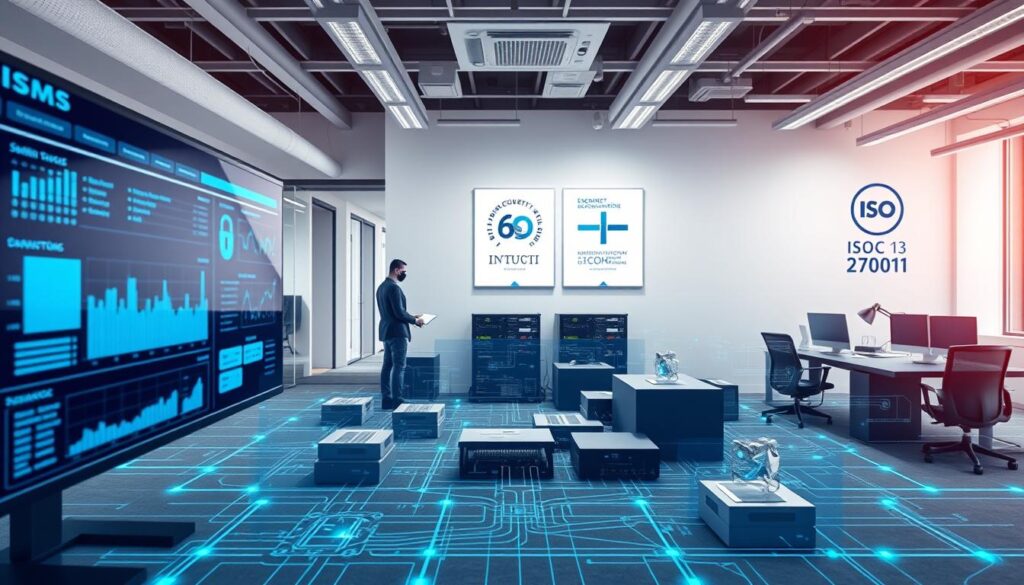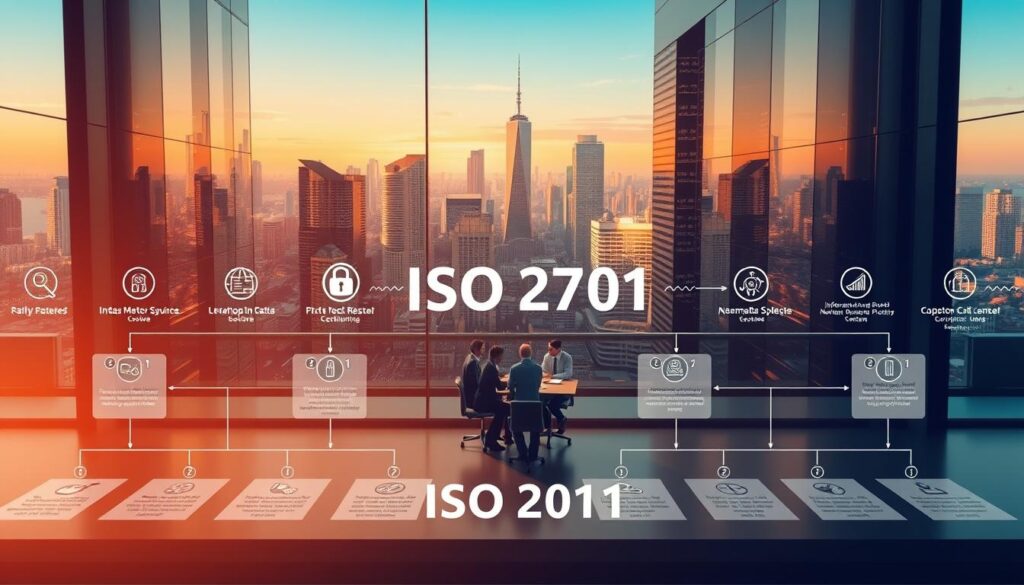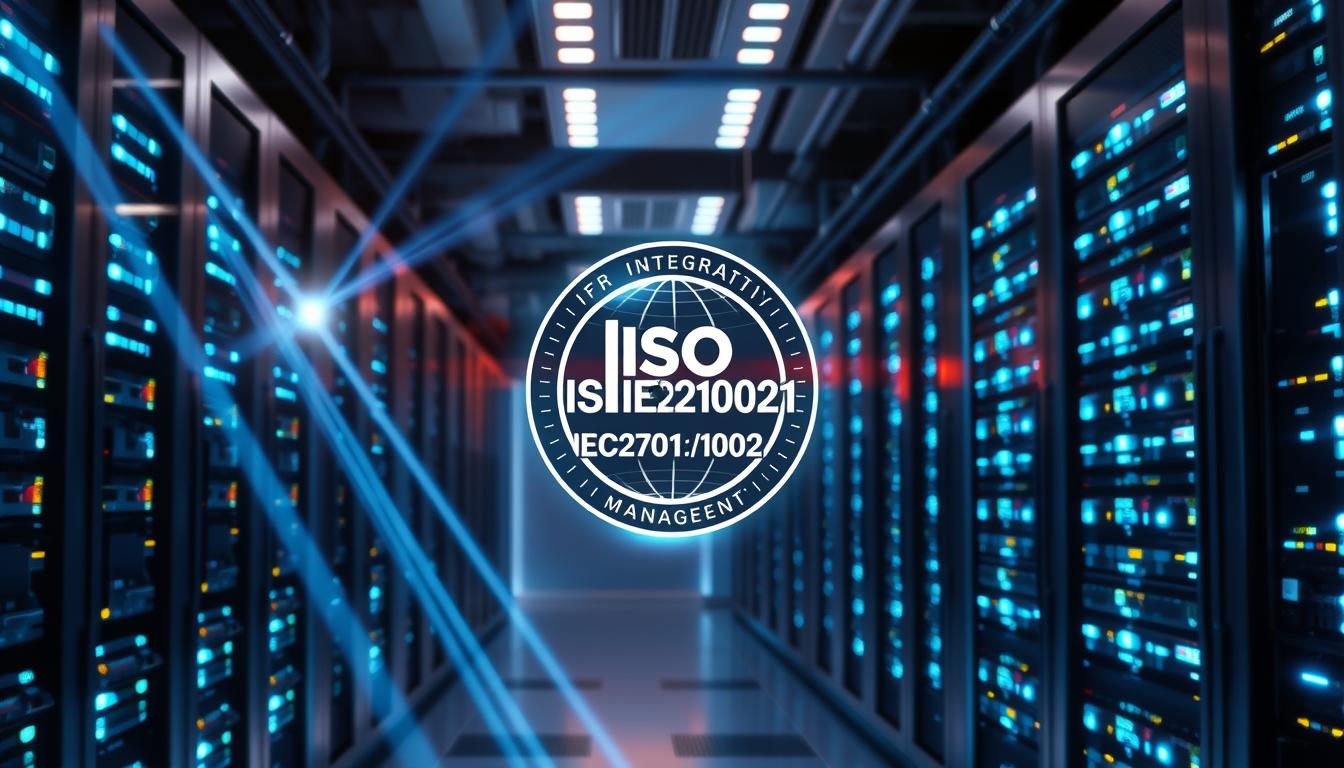Did you know that a single data breach can cost an organization millions of dollars and irreparably damage its reputation? In today’s digital landscape, protecting sensitive information is crucial for businesses of all sizes.
The latest update to a globally recognized standard for information security management systems (ISMS) provides a systematic approach to managing security risks, helping you safeguard your valuable assets.
This comprehensive guide will walk you through the essentials of implementing an effective ISMS, ensuring you’re well-equipped to protect your organization’s information assets.
Key Takeaways
- Understand the role of a globally recognized standard in enhancing information security.
- Learn how to implement a systematic approach to managing security risks.
- Discover the benefits of adopting a robust management system for your organization.
- Gain insights into protecting your valuable information assets.
- Find out how to ensure the continuity of your business through effective security measures.
What is ISO/IEC 27001:2022?
ISO/IEC 27001:2022 represents the latest evolution in information security management systems (ISMS), building on years of development. This standard is crucial for organizations seeking to protect their information assets effectively.
Definition and Purpose
ISO/IEC 27001:2022 is an international standard that specifies the requirements for an information security management system (ISMS). Its primary purpose is to help organizations implement a systematic approach to managing sensitive information securely. The standard provides a framework for organizations to identify and mitigate potential security risks, ensuring the confidentiality, integrity, and availability of their information assets.
The standard is designed to be applicable to all types and sizes of organizations, providing a flexible and scalable approach to information security management.
Evolution from Previous Versions
The journey of ISO/IEC 27001 began with BS 7799, a British standard published in 1995. Over the years, it has undergone significant transformations, with major revisions in 2005, 2013, and now 2022. The 2022 version represents a substantial evolution, restructuring Annex A controls to align with the modernized approach in ISO/IEC 27002:2022. This latest version maintains the high-level structure common to all ISO management system standards, making it easier for organizations to integrate with other management systems.
- The standard has evolved to address changing security landscapes and organizational needs over time.
- It provides a robust framework for managing information security, ensuring the protection of sensitive information.
The Structure of ISO/IEC 27001:2022 – Information Security Management Systems
Understanding the structure of ISO/IEC 27001:2022 is crucial for implementing an effective Information Security Management System (ISMS). The standard provides a comprehensive framework that organizations can follow to manage their information security effectively.
Core Components of the Standard
The core components of ISO/IEC 27001:2022 include the main clauses that outline the requirements for an ISMS. These clauses cover aspects such as information security management, risk assessment, and the implementation of controls. The standard emphasizes the importance of a systematic approach to managing information security.
The main-body clauses (4-10) of the standard maintain a consistent structure, making it easier for organizations to understand and implement the requirements. The clauses are designed to be flexible, allowing organizations to adapt them to their specific needs.
Key Changes in the 2022 Version
The 2022 version of ISO/IEC 27001 introduces significant changes, particularly in Annex A, which now features a completely restructured set of controls aligned with ISO/IEC 27002:2022. The controls have been reorganized into four themes: Organizational, People, Physical, and Technological, making them more logical and easier to implement.
Some key changes include a greater emphasis on modern security challenges such as cloud security, privacy protection, and emerging technologies. Organizations currently certified to ISO/IEC 27001:2013 have until October 31, 2025, to transition to the 2022 version, giving them ample time to adapt to these changes.
Fundamental Principles of ISO/IEC 27001
ISO/IEC 27001 is founded on several fundamental principles that guide organizations in establishing a robust Information Security Management System (ISMS). These principles are crucial for ensuring the effectiveness and efficiency of an organization’s information security practices.
Risk-Based Approach
A key principle of ISO/IEC 27001 is its risk-based approach. This involves identifying, assessing, and mitigating risks to your organization’s information assets. By focusing on risk management, you can prioritize your security efforts and resources on the most critical areas, ensuring a more effective information security management process.
Management Commitment
Management commitment is another vital principle. Top management’s involvement and support are essential for the successful implementation of an ISMS. Their commitment helps in allocating necessary resources and fostering a culture of information security within the organization.
Continual Improvement
The principle of continual improvement is embedded throughout ISO/IEC 27001. This requires your organization to regularly review and enhance your ISMS. By implementing a Plan-Do-Check-Act (PDCA) cycle, you ensure that your ISMS evolves to address changing threats, vulnerabilities, and business requirements. Regular internal audits, management reviews, and corrective actions are essential tools that help you identify weaknesses and opportunities for improvement.
By embracing these principles, your organization develops a proactive security posture that adapts to the evolving threat landscape and maintains its effectiveness over time. This dynamic approach helps you stay ahead of emerging security challenges rather than simply maintaining a static set of controls.
Implementing an Information Security Management System (ISMS)

The process of implementing an Information Security Management System (ISMS) involves several key steps that help organizations manage and reduce information security risks. To achieve this, you need to follow the guidelines set forth in the ISO/IEC 27001:2022 standard, which provides a framework for implementing a robust security management system.
Defining the ISMS Scope
Defining the scope of your ISMS is the first critical step. This involves identifying the boundaries of your ISMS, including the parts of your organization that will be covered. You need to clearly outline what is included and excluded from the scope, ensuring that it is relevant to your organization’s objectives and risk management needs.
Risk Assessment Process
Conducting a thorough risk assessment is essential to identify, assess, and prioritize risks to your organization’s information assets. This process involves analyzing potential threats and vulnerabilities, evaluating their impact, and determining the likelihood of their occurrence. The output of this process will guide your risk treatment decisions.
- Identify information assets and their associated risks.
- Assess the likelihood and potential impact of identified risks.
- Prioritize risks based on their risk score.
Statement of Applicability (SoA)
The Statement of Applicability (SoA) is a crucial document that links your risk assessment results with the implementation of controls. In your SoA, you will document which of the 93 controls from Annex A of ISO/IEC 27001:2022 are applicable to your organization, which are not, and provide justifications for these decisions. This document serves as a blueprint for your security controls, demonstrating how you’ve tailored the standard’s controls to address your specific information security risks.
By following these steps and maintaining a commitment to continual improvement, you can ensure that your ISMS remains effective and aligned with the ISO/IEC 27001:2022 standard, ultimately enhancing your organization’s certification prospects and overall information security posture.
Annex A Controls in ISO/IEC 27001:2022
To effectively manage information security risks, organizations can leverage the controls outlined in Annex A of ISO/IEC 27001:2022. These controls are designed to help mitigate unacceptable information risks and are not mandatory for all organizations; instead, they serve as a checklist to ensure that necessary controls are not overlooked.
Understanding the Control Categories
The controls in Annex A are categorized based on their purpose and the aspects of information security they address. Understanding these categories is crucial for implementing an effective security management system. The categories help organizations identify the most relevant controls for their specific risks and operational needs.
By familiarizing yourself with the control categories, you can better assess which controls are applicable to your organization and how they contribute to a comprehensive information security management system.
How to Select Appropriate Controls
Selecting the right controls from Annex A is a critical process that should be driven by your risk assessment results. You need to evaluate each control based on its relevance to your identified risks, considering factors such as effectiveness, cost, implementation complexity, and alignment with your business objectives.
- Assess the relevance of each control to your organization’s specific risks and needs.
- Consider the effectiveness and feasibility of implementing each control.
- Document justifications for any controls that are not implemented.
By carefully selecting and implementing the appropriate controls, you can strengthen your information security management system and achieve ISO/IEC 27001 compliance.
The Certification Process

The certification process for ISO/IEC 27001 is a rigorous yet rewarding journey that ensures your organization’s information security management system (ISMS) meets international standards. To achieve certification, your organization must undergo an external audit conducted by an accredited certification body.
Preparation and Documentation Requirements
Before the audit, it’s essential to prepare your ISMS documentation, including your information security policy, Statement of Applicability (SoA), and Risk Treatment Plan (RTP). You can find more information on the certification process and requirements on the BSI Group website.
Your documentation should demonstrate a clear understanding of the standard’s requirements and how they are implemented within your organization.
Audit Stages and Maintenance
The ISO/IEC 27001 certification process typically involves two main audit stages: Stage 1 (Documentation Review) and Stage 2 (Implementation Audit). During Stage 1, auditors review your ISMS documentation to verify completeness. In Stage 2, they assess the implementation of your ISMS on-site.
- The audit process involves a thorough examination of your ISMS to ensure it meets the standard’s requirements.
- After successful certification, you’ll undergo surveillance audits at least annually to maintain compliance.
- A full recertification audit is required every three years to ensure continued compliance with the standard.
These ongoing audits help maintain the integrity of your ISMS and provide opportunities for continuous improvement as your organization and the threat landscape evolve.
Benefits of ISO/IEC 27001:2022 Certification
The benefits of ISO/IEC 27001:2022 certification are multifaceted, ranging from enhanced security measures to improved business efficiency and risk management. By adopting this standard, your organization can proactively manage information security risks and improve its overall security posture.
Business Advantages
ISO/IEC 27001:2022 certification can bring significant business advantages. It helps in establishing a robust information security management system that not only protects your organization’s information assets but also enhances customer trust and confidence. The certification demonstrates your commitment to information security, which can be a competitive differentiator in the market.
- Improved risk management through a systematic approach to identifying and mitigating information security risks.
- Enhanced customer trust and confidence due to demonstrated commitment to information security.
- Better alignment of IT and business strategies through a holistic approach to security.
Enhanced Security Posture
The certification also significantly enhances your organization’s security posture. By implementing the controls and best practices outlined in ISO/IEC 27001:2022, you can ensure that your information assets are protected against various threats. The standard’s risk-based approach ensures that your security resources are allocated efficiently, focusing on the most critical areas.
- A comprehensive framework for identifying and addressing information security risks.
- A proactive approach to security, identifying vulnerabilities before they can be exploited.
- Regular reviews and continuous improvement processes to maintain effectiveness over time.
Common Challenges and How to Overcome Them
As you embark on your ISO/IEC 27001:2022 journey, you’ll likely encounter several challenges that can be overcome with the right strategies. Implementing an effective Information Security Management System (ISMS) requires careful planning, resource allocation, and ongoing commitment.
Resource Constraints
One of the primary challenges organizations face is resource constraints. Allocating sufficient time, budget, and personnel can be difficult, especially for smaller organizations. To address this, prioritize your efforts by focusing on high-risk areas first and leveraging external expertise when necessary.
Maintaining Compliance
Maintaining ongoing compliance with ISO/IEC 27001 can be challenging as your organization evolves. To overcome this, establish robust monitoring and measurement processes that provide early indicators when your ISMS effectiveness begins to drift. Integrate information security considerations into your change management processes to ensure new systems or business processes don’t compromise your security posture.
- Regularly review and update your ISMS to reflect changes in your organization and the security landscape.
- Leverage management reviews and internal audits as opportunities for continuous improvement.
- Foster a culture of security awareness throughout your organization.
Relationship with Other Standards and Frameworks
One of the key benefits of ISO/IEC 27001 is its ability to be integrated with other management systems and frameworks. This compatibility is largely due to its adherence to the high-level structure (HLS) common among ISO management system standards.
ISO/IEC 27001 shares this structure with standards like ISO 9001 (quality management) and ISO 14001 (environmental management), allowing for the development of an integrated management system that addresses multiple aspects of organizational performance. This integration minimizes duplication of effort by leveraging shared elements such as document control, internal audits, management reviews, and continual improvement processes across multiple management systems.
ISO/IEC 27002 and the ISO 27000 Family
ISO/IEC 27001 is part of the ISO 27000 family of standards, with ISO/IEC 27002 providing guidelines for implementing the controls mentioned in Annex A of ISO/IEC 27001. The ISO 27000 series offers a comprehensive framework for information security management, with various parts focusing on different aspects such as implementation, measurement, and risk management.
- ISO/IEC 27002 offers detailed guidance on information security controls.
- The ISO 27000 family covers a broad spectrum of information security management topics.
Integration with Other Management Systems
By aligning ISO/IEC 27001 with other management system standards and frameworks like the NIST Cybersecurity Framework or COBIT, organizations can create a cohesive approach to governance, risk, and compliance. This integration supports overall business objectives by providing a comprehensive management system that addresses various organizational needs.
Conclusion
Implementing ISO/IEC 27001:2022 is a strategic decision that enhances your organization’s information security posture. This internationally recognized standard provides a proven framework for establishing, implementing, maintaining, and continually improving your organization’s Information Security Management System (ISMS). By adopting this standard, you demonstrate your commitment to protecting information assets and managing information security risks systematically.
The standard’s risk-based approach ensures that your security efforts are aligned with your business objectives and focused on addressing your most significant information security risks. Whether you pursue certification or simply implement the standard’s best practices, ISO/IEC 27001 can help you build a more resilient organization capable of protecting its valuable information assets. As information security threats continue to evolve, having a structured and systematic approach to information security management becomes increasingly important for organizations of all sizes and across all industries.
